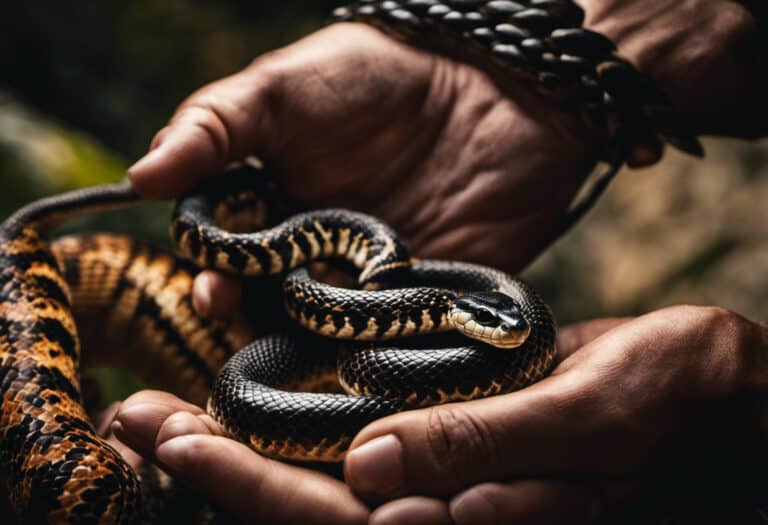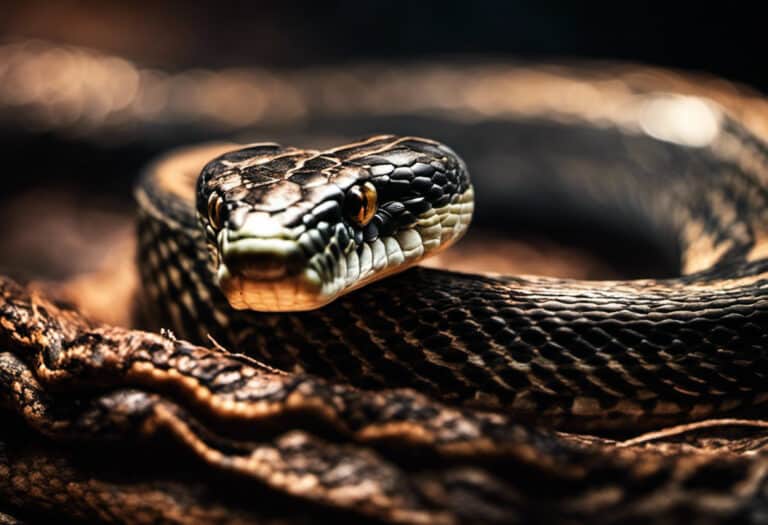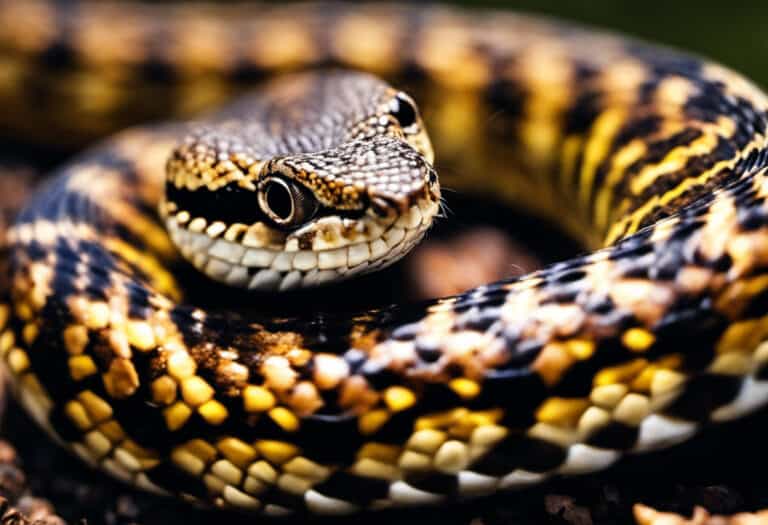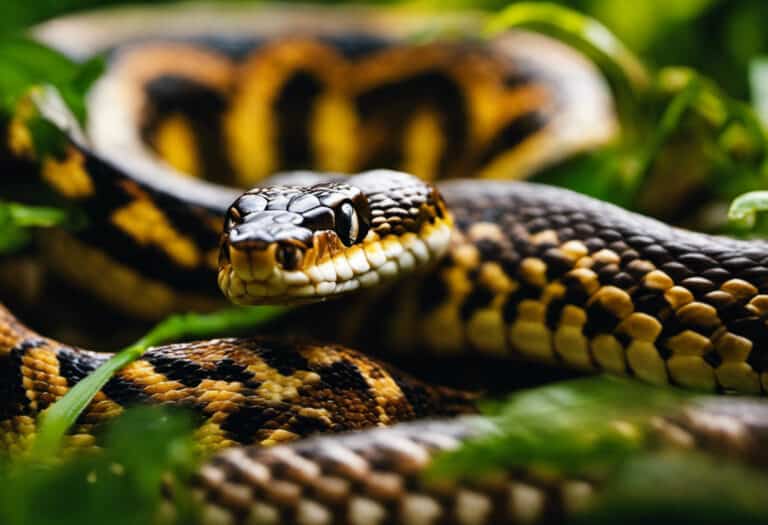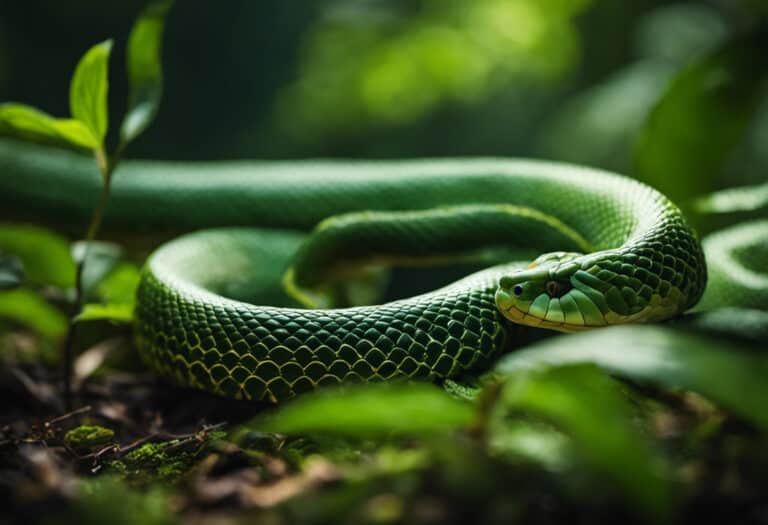Do Garter Snakes Eat Birds?
Do you ever wonder if those small, seemingly harmless garter snakes have a taste for something other than insects and small mammals? Prepare to be surprised.
In this article, we’ll explore the fascinating topic of whether garter snakes eat birds. You’ll discover that these slithery creatures are capable of seeking out and devouring bird eggs, potentially impacting bird populations and nesting behavior.
But fear not, we’ll also discuss methods to deter snakes from bird nests and promote coexistence.
Join us on this intriguing journey into the world of garter snakes and their relationship with our avian friends.
Key Takeaways
- Garter snakes are known to eat bird eggs, which can provide a nutritious meal for them.
- The consumption of bird eggs by garter snakes can impact bird populations and reduce their reproductive success.
- Ground-nesting bird species are particularly vulnerable to garter snake predation.
- There are various methods to deter snakes from bird nests, including the use of physical barriers, decoy predators, and removal of fallen fruit or debris.
Garter Snakes: Non-Venomous Reptiles
Garter snakes, being non-venomous reptiles, have the ability to consume a wide variety of prey, including small birds and rodents.
These snakes exhibit interesting behavior when it comes to their feeding habits. They’re known to be active hunters, using their keen sense of smell to locate their prey.
Garter snakes have a specialized jaw structure that allows them to swallow their prey whole.
This unique adaptation enables them to consume animals that are larger than their own head. However, garter snakes aren’t without their own predators. They’re preyed upon by larger animals such as birds of prey, raccoons, and other snakes.
This constant threat of predation has likely influenced the behavior and survival strategies of garter snakes throughout their evolutionary history.
Habitat and Diet of Garter Snakes
You might be interested to know that garter snakes have a varied diet, which includes small animals such as insects, amphibians, fish, and small mammals.
Garter snakes are known for their adaptability and can thrive in a variety of habitats, ranging from forests and grasslands to wetlands and even urban areas.
They prefer habitats with access to water, as it provides opportunities for hunting fish and amphibians.
Garter snakes are also commonly found near areas with dense vegetation, as it offers cover and potential food sources like insects and small mammals.
Their diet preferences are influenced by their surroundings, allowing them to take advantage of the abundance of food available in their preferred habitats.
Garter Snakes and Bird Eggs
Garter snakes, as opportunistic predators, have the ability to locate and consume bird eggs, which can provide a nutritious meal for them. These snakes may climb trees or bushes to access bird nests and can swallow the eggs whole.
Their consumption of bird eggs can have an impact on bird populations, potentially reducing the reproductive success of birds, especially ground-nesting species.
Bird Eggs as Prey
Bird eggs can provide a nutritious meal for garter snakes, as they have the ability to locate and consume them. Here are some key points about the effect of garter snakes consuming bird eggs and the effectiveness of snake deterrent methods:
Effect on bird reproduction:
- The loss of eggs can reduce the reproductive success of birds.
- Garter snakes can potentially impact ground-nesting bird species.
- Bird species with exposed nests are more vulnerable to snake predation.
- The presence of garter snakes may influence nesting behavior of birds.
Snake deterrent effectiveness:
- Placing a physical barrier around the nest can prevent snake access.
- Using decoy predators, such as owl statues, can deter snakes.
- Regularly removing fallen fruit or debris can discourage snakes.
- Providing alternative food sources for snakes may redirect their attention.
Understanding the impact of garter snakes on bird reproduction and employing effective snake deterrent methods can help promote the coexistence of birds and snakes in the ecosystem.
Impact on Bird Populations
The presence of garter snakes consuming bird eggs can have a negative impact on the overall populations of certain bird species. The loss of bird eggs can significantly affect bird reproduction, reducing their ability to successfully breed and raise offspring.
Ground-nesting bird species are particularly vulnerable to snake predation, as their nests are easily accessible to garter snakes. This can lead to a decline in their numbers and a disruption in the ecosystem.
To protect bird nests from garter snakes, strategies such as placing physical barriers around the nests, using decoy predators like owl statues, regularly removing fallen fruit or debris, and providing alternative food sources for snakes can be implemented. These strategies can help ensure the survival and reproductive success of bird populations.
Snake Deterrent Methods?
You can deter snakes from bird nests by placing physical barriers around the nests or using decoy predators like owl statues. Here are some methods to deter snakes from bird nests:
-
Physical barriers: By installing physical barriers such as wire mesh or fences around the nests, you can prevent snakes from accessing them. These barriers create a physical obstacle that snakes can’t easily overcome.
-
Decoy predators: Placing owl statues or other decoy predators near the nests can trick snakes into thinking that there’s a potential threat nearby. Snakes are known to be cautious around predators, and the presence of these decoys may deter them from approaching the nests.
-
Regular maintenance: Removing fallen fruit or debris from the area around the nests can discourage snakes from being attracted to the area. Snakes are attracted to hiding spots, and by keeping the area clean, you can make it less attractive to them.
-
Providing alternative food sources: By offering alternative food sources for snakes, such as rodent traps or designated feeding areas, you can redirect their attention away from bird nests. This can help reduce the likelihood of snakes targeting bird eggs.
How Garter Snakes Locate and Consume Bird Eggs
Garter snakes possess a remarkable ability to locate and consume bird eggs. They employ a combination of visual and olfactory cues to locate nests, often climbing trees or bushes to access them.
Once they find a nest, they’re capable of swallowing the bird eggs whole, utilizing their flexible jaws and specialized digestive systems to extract the nutritious contents.
Snake Egg Detection
To detect bird eggs, keep in mind that garter snakes have the ability to locate and consume them. Here are some key points to consider:
Snake predation and its impact on bird population dynamics:
- Garter snakes consuming bird eggs can have a negative impact on bird populations.
- The loss of eggs can reduce the reproductive success of birds.
- Ground-nesting bird species are particularly vulnerable to snake predation.
- The presence of garter snakes may influence the nesting behavior of birds.
The ecological significance of garter snakes as bird egg consumers:
- Garter snakes play a role in controlling populations of small animals, including pests.
- By consuming bird eggs, they help regulate bird populations.
- Encouraging natural habitats for garter snakes promotes biodiversity.
- Educating communities about the importance of snakes aids in conservation efforts.
Understanding how garter snakes detect and consume bird eggs is crucial for managing their impact on bird populations and promoting coexistence.
Climbing for Eggs
When climbing trees or bushes, garter snakes can access bird nests and consume their eggs. This climbing behavior allows them to exploit a valuable food source.
The effect of garter snake predation on bird reproductive success is significant. According to studies, the loss of eggs can reduce the overall reproductive success of bird populations. Ground-nesting bird species are particularly vulnerable to snake predation. Birds with exposed nests are more likely to be targeted by garter snakes.
The presence of garter snakes in an area can influence the nesting behavior of birds, potentially leading to changes in their habitat selection. Understanding and mitigating the impact of garter snake predation on bird populations is important for maintaining healthy ecosystems.
Nutritional Value of Eggs
Eggs, like those laid by birds, provide a nutritious meal for you, the garter snake. As a snake, you have the ability to locate and consume bird eggs, which can serve as a valuable food source for your diet. Bird eggs are rich in nutrients and can contribute to your overall health and well-being.
By consuming bird eggs, you are able to obtain essential proteins, fats, and minerals that are necessary for your survival.
Benefits of bird eggs for garter snake diet:
-
Nutritional value: Bird eggs are packed with nutrients, including proteins, fats, and vitamins, which are vital for your growth and development.
-
Energy source: The high-fat content in bird eggs provides you with the energy needed for various physiological processes and activities.
-
Easy digestion: The soft and easily digestible nature of bird eggs allows you to efficiently extract nutrients from them.
-
Abundance: Bird eggs are often found in large quantities, providing you with a readily available and abundant food source.
As garter snakes play a role in controlling pest populations, incorporating bird eggs into your diet can help maintain the balance of ecosystems by reducing the numbers of pest species.
By regulating the populations of small animals, including pests, you contribute to the overall health of the ecosystem.
This natural control of pest populations can minimize the need for chemical pesticides, promoting a more sustainable and environmentally friendly approach to pest management.
Nutritional Value of Bird Eggs for Garter Snakes
Bird eggs can provide a nutritious meal for you, as a garter snake. As an opportunistic predator, garter snakes have the ability to locate and consume bird eggs. These eggs offer a rich source of protein and essential nutrients, contributing to the overall health and survival of garter snakes.
However, the consumption of bird eggs by garter snakes can have ecological implications. It can impact bird populations, reducing their reproductive success and potentially influencing their nesting behavior.
To address this issue, conservation strategies can be implemented. Placing physical barriers around bird nests, using decoy predators, regularly removing fallen fruit or debris, and providing alternative food sources for snakes are some effective strategies.
These conservation efforts promote coexistence between garter snakes and birds while ensuring the preservation of biodiversity.
Garter Snakes Climbing Trees and Bushes
You can often find garter snakes climbing trees and bushes to access their prey or potential food sources. This climbing behavior and nest accessibility can have a significant impact on bird populations. Here’s why:
-
Climbing behavior and nest accessibility: Garter snakes have the ability to climb trees and bushes, allowing them to reach bird nests that are located above the ground. This behavior enables them to access bird eggs, which provide a nutritious meal for the snakes.
-
Predation impact on bird populations: Garter snakes consuming bird eggs can have negative consequences for bird populations. The loss of eggs reduces the reproductive success of birds, especially ground-nesting species. Birds with exposed nests are more vulnerable to snake predation, and the presence of garter snakes may influence their nesting behavior.
To address this issue, various snake deterrent methods can be employed, such as physical barriers around nests, decoy predators, regular removal of fallen fruit or debris, and providing alternative food sources for snakes.
Promoting coexistence and conservation efforts can also help maintain the important role of garter snakes in the ecosystem while protecting bird populations.
Impact of Garter Snakes on Bird Populations
If garter snakes consume bird eggs, it can have a significant impact on the reproductive success of bird populations. Garter snakes are known to eat bird eggs and have the ability to locate and consume them. Bird eggs provide a nutritious meal for garter snakes, and they may even climb trees or bushes to access bird nests.
This snake predation can affect bird populations, especially ground-nesting species. Birds with exposed nests are more vulnerable to snake predation. The loss of eggs can reduce the reproductive success of birds, and the presence of garter snakes may influence nesting behavior.
To mitigate this effect on bird reproduction, deterrent methods can be employed, such as physical barriers around nests, decoy predators, and removing fallen fruit or debris. Promoting coexistence and conservation efforts through education and implementing snake-friendly practices can also help protect vulnerable bird species from snake predation.
Vulnerability of Ground-Nesting Bird Species
Ground-nesting bird species are more susceptible to snake predation due to the exposure of their nests. This vulnerability can have a significant impact on bird populations, particularly when it comes to the presence of garter snakes.
Here are four key points to consider:
-
Garter snakes are known to eat bird eggs and have the ability to locate and consume them. Bird eggs provide a nutritious meal for these snakes, and they can swallow them whole.
-
The consumption of bird eggs by garter snakes can reduce the reproductive success of birds. This can have a direct impact on ground-nesting bird species, which are more vulnerable to snake predation.
-
The presence of garter snakes may influence the nesting behavior of birds. The fear of predation may lead birds to choose different nesting sites or alter their nesting behaviors to minimize the risk of snake predation.
-
To mitigate the impact of garter snakes on bird populations, various snake deterrent methods can be employed. These include placing physical barriers around nests, using decoy predators, removing fallen fruit or debris, and providing alternative food sources for snakes.
Understanding the vulnerability of ground-nesting bird species and the impact of garter snakes on bird populations is crucial for conservation efforts. By implementing effective strategies, we can help protect these bird species and promote their freedom to thrive.
Influence of Garter Snakes on Bird Nesting Behavior
The presence of garter snakes may alter where you, as a bird, choose to build your nests or how you behave while nesting. These snakes are known to eat bird eggs, and their ability to locate and consume them can have a significant influence on your nesting behavior.
If you’re a ground-nesting bird species, you may be more vulnerable to snake predation. The loss of eggs due to garter snakes can reduce your reproductive success and impact your population.
However, it’s important to remember that garter snakes play a role in the ecosystem as predators, helping to control populations of small animals. Promoting coexistence with garter snakes and implementing snake-friendly practices can aid conservation efforts and promote biodiversity.
Frequently Asked Questions
Are Garter Snakes Harmful to Humans?
Garter snakes are not harmful to humans. They are non-venomous reptiles and their bite is typically harmless. Garter snake venom is not a concern and garter snake bite symptoms are usually minimal, such as minor swelling or redness.
Do Garter Snakes Lay Eggs?
Garter snakes reproduce by laying eggs. They have unique nesting habits, often choosing warm and protected areas to lay their eggs. These snakes are fascinating creatures, capable of adapting to various environments.
How Long Do Garter Snakes Live?
Garter snakes have an average lifespan of around 5-10 years in the wild. They inhabit a variety of habitats, including forests, grasslands, and wetlands. Their adaptability allows them to thrive in various environments.
Can Garter Snakes Swim?
Garter snakes are excellent swimmers and can navigate various aquatic habitats. They are well-adapted to their environment, with streamlined bodies and scales that aid in swimming. Snake behavior and habitat play a crucial role in their swimming abilities.
Do Garter Snakes Hibernate During the Winter?
Garter snakes do hibernate during winter. They seek shelter in underground dens or crevices to survive the cold. Their adaptations include slowing down metabolism and reducing activity to conserve energy until spring arrives.
Conclusion
In conclusion, garter snakes have the remarkable ability to locate and consume bird eggs, which provides them with a nutritious meal. This behavior can have implications for bird populations, impacting their reproductive success and nesting behavior.
However, by implementing methods to deter snakes from bird nests and promoting coexistence, we can aid in conservation efforts. Understanding the complex relationship between garter snakes and birds is crucial for preserving the delicate balance of our ecosystems.
